How to Add to a Set in Python
Watch Now This tutorial has a related video course created by the Real Python team. Watch it together with the written tutorial to deepen your understanding: Sets in Python
Perhaps you recall learning about sets and set theory at some point in your mathematical education. Maybe you even remember Venn diagrams:
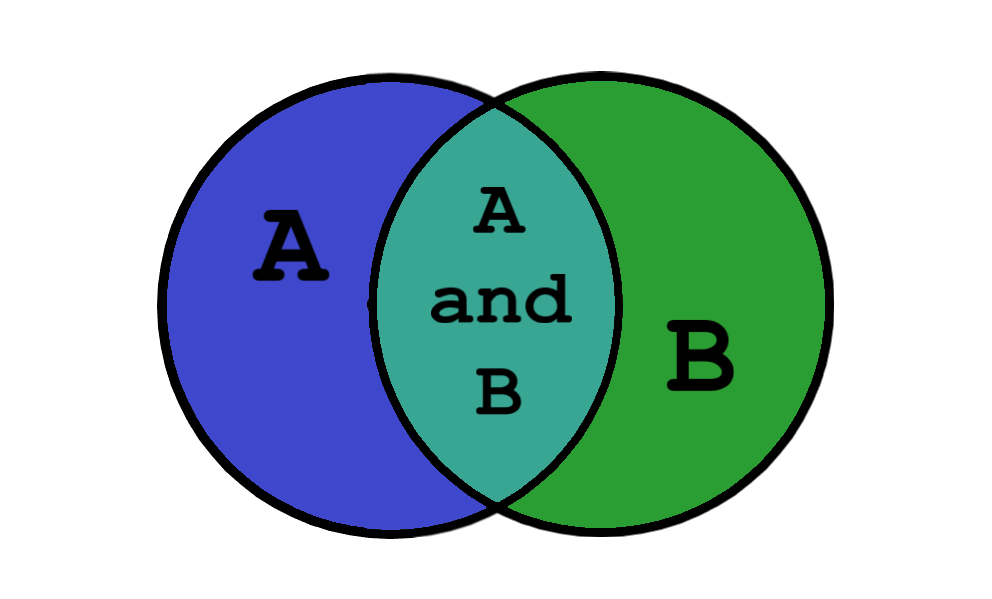
If this doesn't ring a bell, don't worry! This tutorial should still be easily accessible for you.
In mathematics, a rigorous definition of a set can be abstract and difficult to grasp. Practically though, a set can be thought of simply as a well-defined collection of distinct objects, typically called elements or members.
Grouping objects into a set can be useful in programming as well, and Python provides a built-in set type to do so. Sets are distinguished from other object types by the unique operations that can be performed on them.
Here's what you'll learn in this tutorial: You'll see how to define set objects in Python and discover the operations that they support. As with the earlier tutorials on lists and dictionaries, when you are finished with this tutorial, you should have a good feel for when a set is an appropriate choice. You will also learn about frozen sets, which are similar to sets except for one important detail.
Defining a Set
Python's built-in set type has the following characteristics:
- Sets are unordered.
- Set elements are unique. Duplicate elements are not allowed.
- A set itself may be modified, but the elements contained in the set must be of an immutable type.
Let's see what all that means, and how you can work with sets in Python.
A set can be created in two ways. First, you can define a set with the built-in set() function:
In this case, the argument <iter> is an iterable—again, for the moment, think list or tuple—that generates the list of objects to be included in the set. This is analogous to the <iter> argument given to the .extend() list method:
>>>
>>> x = set ([ 'foo' , 'bar' , 'baz' , 'foo' , 'qux' ]) >>> x {'qux', 'foo', 'bar', 'baz'} >>> x = set (( 'foo' , 'bar' , 'baz' , 'foo' , 'qux' )) >>> x {'qux', 'foo', 'bar', 'baz'} Strings are also iterable, so a string can be passed to set() as well. You have already seen that list(s) generates a list of the characters in the string s. Similarly, set(s) generates a set of the characters in s:
>>>
>>> s = 'quux' >>> list ( s ) ['q', 'u', 'u', 'x'] >>> set ( s ) {'x', 'u', 'q'} You can see that the resulting sets are unordered: the original order, as specified in the definition, is not necessarily preserved. Additionally, duplicate values are only represented in the set once, as with the string 'foo' in the first two examples and the letter 'u' in the third.
Alternately, a set can be defined with curly braces ({}):
x = { < obj > , < obj > , ... , < obj > } When a set is defined this way, each <obj> becomes a distinct element of the set, even if it is an iterable. This behavior is similar to that of the .append() list method.
Thus, the sets shown above can also be defined like this:
>>>
>>> x = { 'foo' , 'bar' , 'baz' , 'foo' , 'qux' } >>> x {'qux', 'foo', 'bar', 'baz'} >>> x = { 'q' , 'u' , 'u' , 'x' } >>> x {'x', 'q', 'u'} To recap:
- The argument to
set()is an iterable. It generates a list of elements to be placed into the set. - The objects in curly braces are placed into the set intact, even if they are iterable.
Observe the difference between these two set definitions:
>>>
>>> { 'foo' } {'foo'} >>> set ( 'foo' ) {'o', 'f'} A set can be empty. However, recall that Python interprets empty curly braces ({}) as an empty dictionary, so the only way to define an empty set is with the set() function:
>>>
>>> x = set () >>> type ( x ) <class 'set'> >>> x set() >>> x = {} >>> type ( x ) <class 'dict'> An empty set is falsy in a Boolean context:
>>>
>>> x = set () >>> bool ( x ) False >>> x or 1 1 >>> x and 1 set() You might think the most intuitive sets would contain similar objects—for example, even numbers or surnames:
>>>
>>> s1 = { 2 , 4 , 6 , 8 , 10 } >>> s2 = { 'Smith' , 'McArthur' , 'Wilson' , 'Johansson' } Python does not require this, though. The elements in a set can be objects of different types:
>>>
>>> x = { 42 , 'foo' , 3.14159 , None } >>> x {None, 'foo', 42, 3.14159} Don't forget that set elements must be immutable. For example, a tuple may be included in a set:
>>>
>>> x = { 42 , 'foo' , ( 1 , 2 , 3 ), 3.14159 } >>> x {42, 'foo', 3.14159, (1, 2, 3)} But lists and dictionaries are mutable, so they can't be set elements:
>>>
>>> a = [ 1 , 2 , 3 ] >>> { a } Traceback (most recent call last): File "<pyshell#70>", line 1, in <module> { a } TypeError: unhashable type: 'list' >>> d = { 'a' : 1 , 'b' : 2 } >>> { d } Traceback (most recent call last): File "<pyshell#72>", line 1, in <module> { d } TypeError: unhashable type: 'dict' Set Size and Membership
The len() function returns the number of elements in a set, and the in and not in operators can be used to test for membership:
>>>
>>> x = { 'foo' , 'bar' , 'baz' } >>> len ( x ) 3 >>> 'bar' in x True >>> 'qux' in x False Operating on a Set
Many of the operations that can be used for Python's other composite data types don't make sense for sets. For example, sets can't be indexed or sliced. However, Python provides a whole host of operations on set objects that generally mimic the operations that are defined for mathematical sets.
Operators vs. Methods
Most, though not quite all, set operations in Python can be performed in two different ways: by operator or by method. Let's take a look at how these operators and methods work, using set union as an example.
Given two sets, x1 and x2, the union of x1 and x2 is a set consisting of all elements in either set.
Consider these two sets:
x1 = { 'foo' , 'bar' , 'baz' } x2 = { 'baz' , 'qux' , 'quux' } The union of x1 and x2 is {'foo', 'bar', 'baz', 'qux', 'quux'}.
In Python, set union can be performed with the | operator:
>>>
>>> x1 = { 'foo' , 'bar' , 'baz' } >>> x2 = { 'baz' , 'qux' , 'quux' } >>> x1 | x2 {'baz', 'quux', 'qux', 'bar', 'foo'} Set union can also be obtained with the .union() method. The method is invoked on one of the sets, and the other is passed as an argument:
>>>
>>> x1 . union ( x2 ) {'baz', 'quux', 'qux', 'bar', 'foo'} The way they are used in the examples above, the operator and method behave identically. But there is a subtle difference between them. When you use the | operator, both operands must be sets. The .union() method, on the other hand, will take any iterable as an argument, convert it to a set, and then perform the union.
Observe the difference between these two statements:
>>>
>>> x1 | ( 'baz' , 'qux' , 'quux' ) Traceback (most recent call last): File "<pyshell#43>", line 1, in <module> x1 | ( 'baz' , 'qux' , 'quux' ) TypeError: unsupported operand type(s) for |: 'set' and 'tuple' >>> x1 . union (( 'baz' , 'qux' , 'quux' )) {'baz', 'quux', 'qux', 'bar', 'foo'} Both attempt to compute the union of x1 and the tuple ('baz', 'qux', 'quux'). This fails with the | operator but succeeds with the .union() method.
Available Operators and Methods
Below is a list of the set operations available in Python. Some are performed by operator, some by method, and some by both. The principle outlined above generally applies: where a set is expected, methods will typically accept any iterable as an argument, but operators require actual sets as operands.
x1.union(x2[, x3 ...])
x1 | x2 [| x3 ...]
Compute the union of two or more sets.
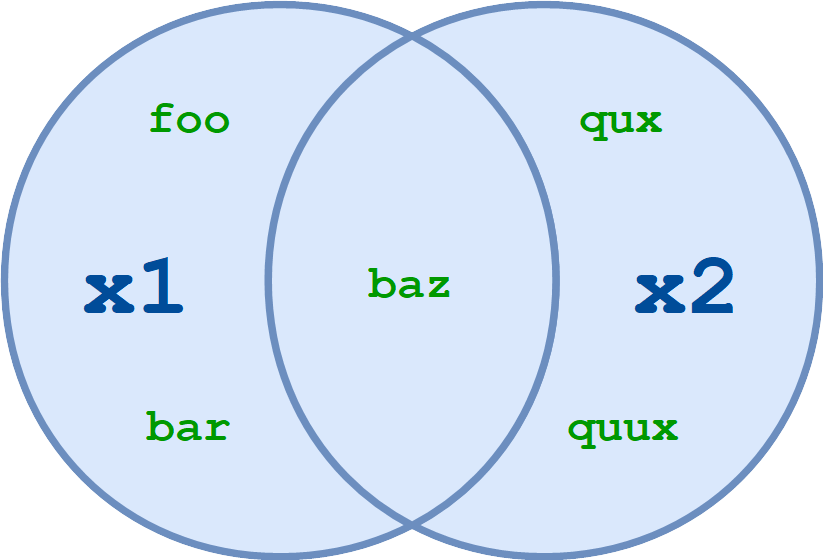
x1.union(x2) and x1 | x2 both return the set of all elements in either x1 or x2:
>>>
>>> x1 = { 'foo' , 'bar' , 'baz' } >>> x2 = { 'baz' , 'qux' , 'quux' } >>> x1 . union ( x2 ) {'foo', 'qux', 'quux', 'baz', 'bar'} >>> x1 | x2 {'foo', 'qux', 'quux', 'baz', 'bar'} More than two sets may be specified with either the operator or the method:
>>>
>>> a = { 1 , 2 , 3 , 4 } >>> b = { 2 , 3 , 4 , 5 } >>> c = { 3 , 4 , 5 , 6 } >>> d = { 4 , 5 , 6 , 7 } >>> a . union ( b , c , d ) {1, 2, 3, 4, 5, 6, 7} >>> a | b | c | d {1, 2, 3, 4, 5, 6, 7} The resulting set contains all elements that are present in any of the specified sets.
x1.intersection(x2[, x3 ...])
x1 & x2 [& x3 ...]
Compute the intersection of two or more sets.
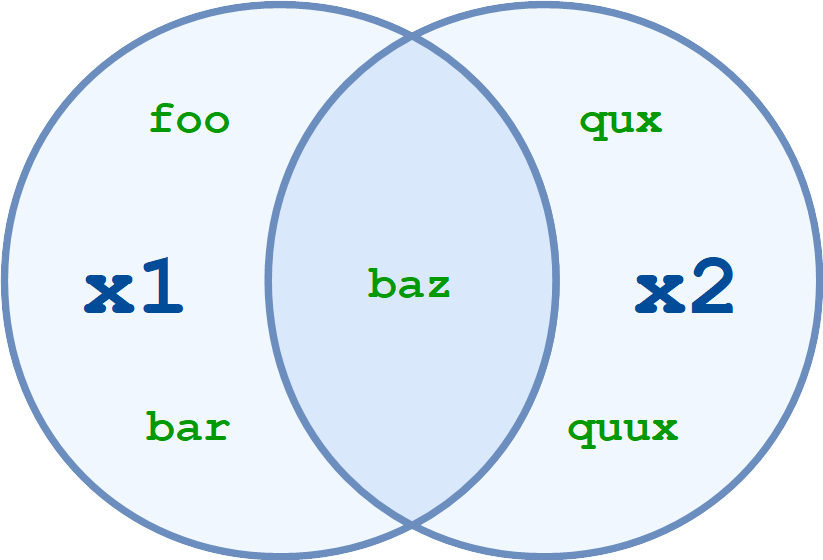
x1.intersection(x2) and x1 & x2 return the set of elements common to both x1 and x2:
>>>
>>> x1 = { 'foo' , 'bar' , 'baz' } >>> x2 = { 'baz' , 'qux' , 'quux' } >>> x1 . intersection ( x2 ) {'baz'} >>> x1 & x2 {'baz'} You can specify multiple sets with the intersection method and operator, just like you can with set union:
>>>
>>> a = { 1 , 2 , 3 , 4 } >>> b = { 2 , 3 , 4 , 5 } >>> c = { 3 , 4 , 5 , 6 } >>> d = { 4 , 5 , 6 , 7 } >>> a . intersection ( b , c , d ) {4} >>> a & b & c & d {4} The resulting set contains only elements that are present in all of the specified sets.
x1.difference(x2[, x3 ...])
x1 - x2 [- x3 ...]
Compute the difference between two or more sets.
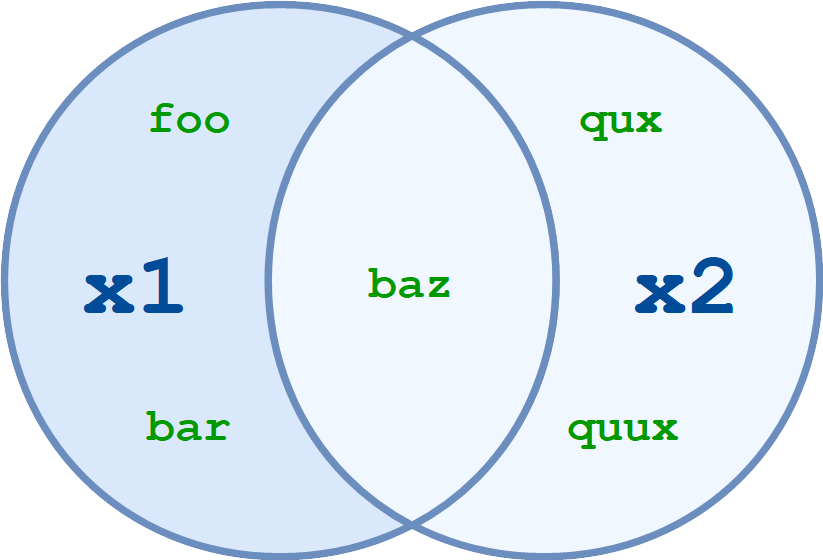
x1.difference(x2) and x1 - x2 return the set of all elements that are in x1 but not in x2:
>>>
>>> x1 = { 'foo' , 'bar' , 'baz' } >>> x2 = { 'baz' , 'qux' , 'quux' } >>> x1 . difference ( x2 ) {'foo', 'bar'} >>> x1 - x2 {'foo', 'bar'} Another way to think of this is that x1.difference(x2) and x1 - x2 return the set that results when any elements in x2 are removed or subtracted from x1.
Once again, you can specify more than two sets:
>>>
>>> a = { 1 , 2 , 3 , 30 , 300 } >>> b = { 10 , 20 , 30 , 40 } >>> c = { 100 , 200 , 300 , 400 } >>> a . difference ( b , c ) {1, 2, 3} >>> a - b - c {1, 2, 3} When multiple sets are specified, the operation is performed from left to right. In the example above, a - b is computed first, resulting in {1, 2, 3, 300}. Then c is subtracted from that set, leaving {1, 2, 3}:
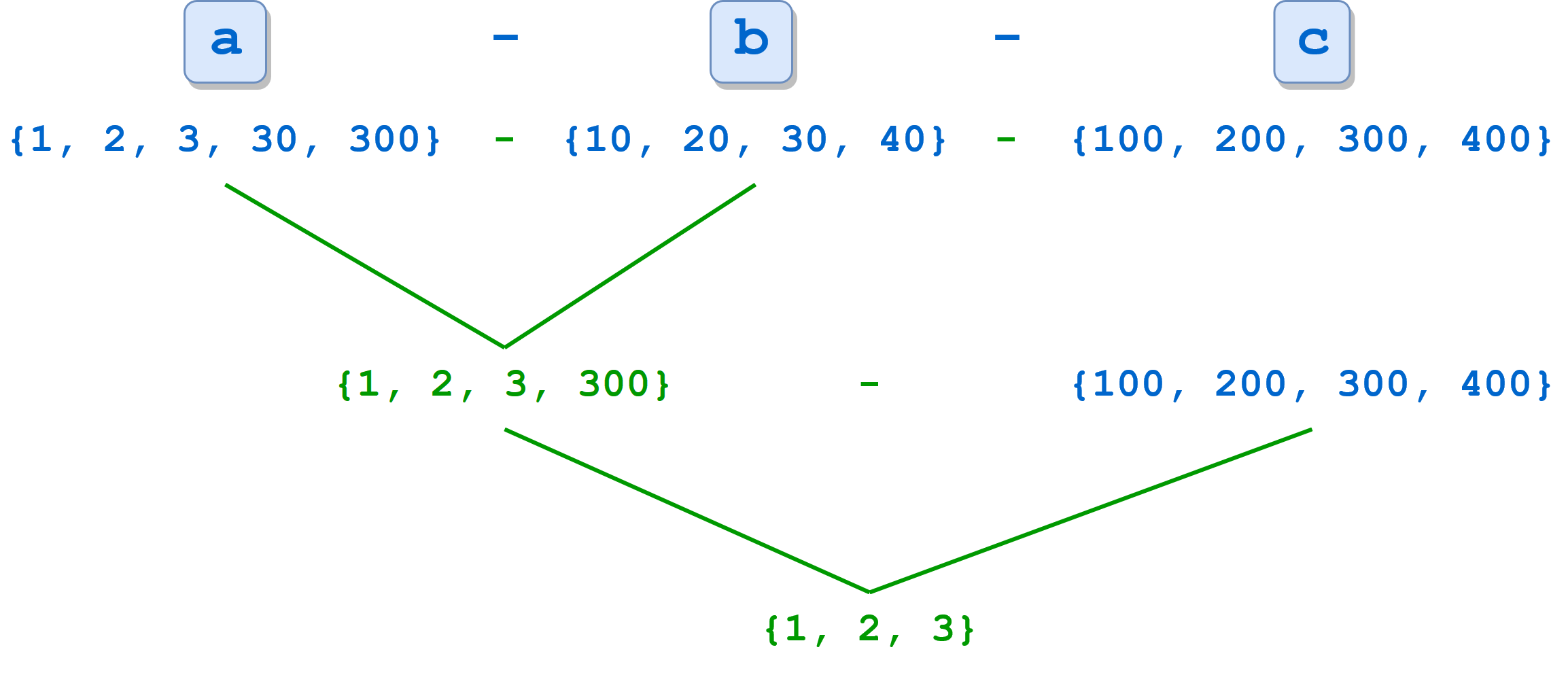
x1.symmetric_difference(x2)
x1 ^ x2 [^ x3 ...]
Compute the symmetric difference between sets.
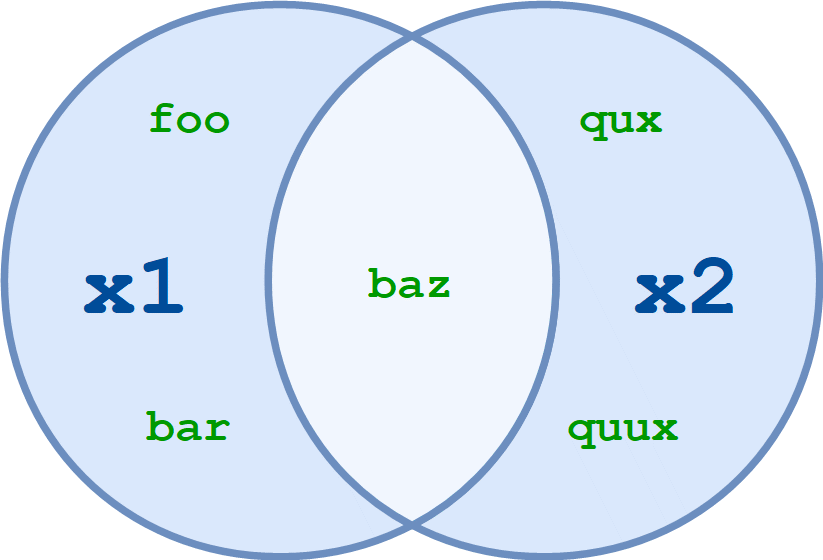
x1.symmetric_difference(x2) and x1 ^ x2 return the set of all elements in either x1 or x2, but not both:
>>>
>>> x1 = { 'foo' , 'bar' , 'baz' } >>> x2 = { 'baz' , 'qux' , 'quux' } >>> x1 . symmetric_difference ( x2 ) {'foo', 'qux', 'quux', 'bar'} >>> x1 ^ x2 {'foo', 'qux', 'quux', 'bar'} The ^ operator also allows more than two sets:
>>>
>>> a = { 1 , 2 , 3 , 4 , 5 } >>> b = { 10 , 2 , 3 , 4 , 50 } >>> c = { 1 , 50 , 100 } >>> a ^ b ^ c {100, 5, 10} As with the difference operator, when multiple sets are specified, the operation is performed from left to right.
Curiously, although the ^ operator allows multiple sets, the .symmetric_difference() method doesn't:
>>>
>>> a = { 1 , 2 , 3 , 4 , 5 } >>> b = { 10 , 2 , 3 , 4 , 50 } >>> c = { 1 , 50 , 100 } >>> a . symmetric_difference ( b , c ) Traceback (most recent call last): File "<pyshell#11>", line 1, in <module> a . symmetric_difference ( b , c ) TypeError: symmetric_difference() takes exactly one argument (2 given) x1.isdisjoint(x2)
Determines whether or not two sets have any elements in common.
x1.isdisjoint(x2) returns True if x1 and x2 have no elements in common:
>>>
>>> x1 = { 'foo' , 'bar' , 'baz' } >>> x2 = { 'baz' , 'qux' , 'quux' } >>> x1 . isdisjoint ( x2 ) False >>> x2 - { 'baz' } {'quux', 'qux'} >>> x1 . isdisjoint ( x2 - { 'baz' }) True If x1.isdisjoint(x2) is True, then x1 & x2 is the empty set:
>>>
>>> x1 = { 1 , 3 , 5 } >>> x2 = { 2 , 4 , 6 } >>> x1 . isdisjoint ( x2 ) True >>> x1 & x2 set() x1.issubset(x2)
x1 <= x2
Determine whether one set is a subset of the other.
In set theory, a set x1 is considered a subset of another set x2 if every element of x1 is in x2.
x1.issubset(x2) and x1 <= x2 return True if x1 is a subset of x2:
>>>
>>> x1 = { 'foo' , 'bar' , 'baz' } >>> x1 . issubset ({ 'foo' , 'bar' , 'baz' , 'qux' , 'quux' }) True >>> x2 = { 'baz' , 'qux' , 'quux' } >>> x1 <= x2 False A set is considered to be a subset of itself:
>>>
>>> x = { 1 , 2 , 3 , 4 , 5 } >>> x . issubset ( x ) True >>> x <= x True It seems strange, perhaps. But it fits the definition—every element of x is in x.
x1 < x2
Determines whether one set is a proper subset of the other.
A proper subset is the same as a subset, except that the sets can't be identical. A set x1 is considered a proper subset of another set x2 if every element of x1 is in x2, and x1 and x2 are not equal.
x1 < x2 returns True if x1 is a proper subset of x2:
>>>
>>> x1 = { 'foo' , 'bar' } >>> x2 = { 'foo' , 'bar' , 'baz' } >>> x1 < x2 True >>> x1 = { 'foo' , 'bar' , 'baz' } >>> x2 = { 'foo' , 'bar' , 'baz' } >>> x1 < x2 False While a set is considered a subset of itself, it is not a proper subset of itself:
>>>
>>> x = { 1 , 2 , 3 , 4 , 5 } >>> x <= x True >>> x < x False x1.issuperset(x2)
x1 >= x2
Determine whether one set is a superset of the other.
A superset is the reverse of a subset. A set x1 is considered a superset of another set x2 if x1 contains every element of x2.
x1.issuperset(x2) and x1 >= x2 return True if x1 is a superset of x2:
>>>
>>> x1 = { 'foo' , 'bar' , 'baz' } >>> x1 . issuperset ({ 'foo' , 'bar' }) True >>> x2 = { 'baz' , 'qux' , 'quux' } >>> x1 >= x2 False You have already seen that a set is considered a subset of itself. A set is also considered a superset of itself:
>>>
>>> x = { 1 , 2 , 3 , 4 , 5 } >>> x . issuperset ( x ) True >>> x >= x True x1 > x2
Determines whether one set is a proper superset of the other.
A proper superset is the same as a superset, except that the sets can't be identical. A set x1 is considered a proper superset of another set x2 if x1 contains every element of x2, and x1 and x2 are not equal.
x1 > x2 returns True if x1 is a proper superset of x2:
>>>
>>> x1 = { 'foo' , 'bar' , 'baz' } >>> x2 = { 'foo' , 'bar' } >>> x1 > x2 True >>> x1 = { 'foo' , 'bar' , 'baz' } >>> x2 = { 'foo' , 'bar' , 'baz' } >>> x1 > x2 False A set is not a proper superset of itself:
>>>
>>> x = { 1 , 2 , 3 , 4 , 5 } >>> x > x False Modifying a Set
Although the elements contained in a set must be of immutable type, sets themselves can be modified. Like the operations above, there are a mix of operators and methods that can be used to change the contents of a set.
Augmented Assignment Operators and Methods
Each of the union, intersection, difference, and symmetric difference operators listed above has an augmented assignment form that can be used to modify a set. For each, there is a corresponding method as well.
x1.update(x2[, x3 ...])
x1 |= x2 [| x3 ...]
Modify a set by union.
x1.update(x2) and x1 |= x2 add to x1 any elements in x2 that x1 does not already have:
>>>
>>> x1 = { 'foo' , 'bar' , 'baz' } >>> x2 = { 'foo' , 'baz' , 'qux' } >>> x1 |= x2 >>> x1 {'qux', 'foo', 'bar', 'baz'} >>> x1 . update ([ 'corge' , 'garply' ]) >>> x1 {'qux', 'corge', 'garply', 'foo', 'bar', 'baz'} x1.intersection_update(x2[, x3 ...])
x1 &= x2 [& x3 ...]
Modify a set by intersection.
x1.intersection_update(x2) and x1 &= x2 update x1, retaining only elements found in both x1 and x2:
>>>
>>> x1 = { 'foo' , 'bar' , 'baz' } >>> x2 = { 'foo' , 'baz' , 'qux' } >>> x1 &= x2 >>> x1 {'foo', 'baz'} >>> x1 . intersection_update ([ 'baz' , 'qux' ]) >>> x1 {'baz'} x1.difference_update(x2[, x3 ...])
x1 -= x2 [| x3 ...]
Modify a set by difference.
x1.difference_update(x2) and x1 -= x2 update x1, removing elements found in x2:
>>>
>>> x1 = { 'foo' , 'bar' , 'baz' } >>> x2 = { 'foo' , 'baz' , 'qux' } >>> x1 -= x2 >>> x1 {'bar'} >>> x1 . difference_update ([ 'foo' , 'bar' , 'qux' ]) >>> x1 set() x1.symmetric_difference_update(x2)
x1 ^= x2
Modify a set by symmetric difference.
x1.symmetric_difference_update(x2) and x1 ^= x2 update x1, retaining elements found in either x1 or x2, but not both:
>>>
>>> x1 = { 'foo' , 'bar' , 'baz' } >>> x2 = { 'foo' , 'baz' , 'qux' } >>> >>> x1 ^= x2 >>> x1 {'bar', 'qux'} >>> >>> x1 . symmetric_difference_update ([ 'qux' , 'corge' ]) >>> x1 {'bar', 'corge'} Other Methods For Modifying Sets
Aside from the augmented operators above, Python supports several additional methods that modify sets.
x.add(<elem>)
Adds an element to a set.
x.add(<elem>) adds <elem>, which must be a single immutable object, to x:
>>>
>>> x = { 'foo' , 'bar' , 'baz' } >>> x . add ( 'qux' ) >>> x {'bar', 'baz', 'foo', 'qux'} x.remove(<elem>)
Removes an element from a set.
x.remove(<elem>) removes <elem> from x. Python raises an exception if <elem> is not in x:
>>>
>>> x = { 'foo' , 'bar' , 'baz' } >>> x . remove ( 'baz' ) >>> x {'bar', 'foo'} >>> x . remove ( 'qux' ) Traceback (most recent call last): File "<pyshell#58>", line 1, in <module> x . remove ( 'qux' ) KeyError: 'qux' x.discard(<elem>)
Removes an element from a set.
x.discard(<elem>) also removes <elem> from x. However, if <elem> is not in x, this method quietly does nothing instead of raising an exception:
>>>
>>> x = { 'foo' , 'bar' , 'baz' } >>> x . discard ( 'baz' ) >>> x {'bar', 'foo'} >>> x . discard ( 'qux' ) >>> x {'bar', 'foo'} x.pop()
Removes a random element from a set.
x.pop() removes and returns an arbitrarily chosen element from x. If x is empty, x.pop() raises an exception:
>>>
>>> x = { 'foo' , 'bar' , 'baz' } >>> x . pop () 'bar' >>> x {'baz', 'foo'} >>> x . pop () 'baz' >>> x {'foo'} >>> x . pop () 'foo' >>> x set() >>> x . pop () Traceback (most recent call last): File "<pyshell#82>", line 1, in <module> x . pop () KeyError: 'pop from an empty set' x.clear()
Clears a set.
x.clear() removes all elements from x:
>>>
>>> x = { 'foo' , 'bar' , 'baz' } >>> x {'foo', 'bar', 'baz'} >>> >>> x . clear () >>> x set() Frozen Sets
Python provides another built-in type called a frozenset, which is in all respects exactly like a set, except that a frozenset is immutable. You can perform non-modifying operations on a frozenset:
>>>
>>> x = frozenset ([ 'foo' , 'bar' , 'baz' ]) >>> x frozenset({'foo', 'baz', 'bar'}) >>> len ( x ) 3 >>> x & { 'baz' , 'qux' , 'quux' } frozenset({'baz'}) But methods that attempt to modify a frozenset fail:
>>>
>>> x = frozenset ([ 'foo' , 'bar' , 'baz' ]) >>> x . add ( 'qux' ) Traceback (most recent call last): File "<pyshell#127>", line 1, in <module> x . add ( 'qux' ) AttributeError: 'frozenset' object has no attribute 'add' >>> x . pop () Traceback (most recent call last): File "<pyshell#129>", line 1, in <module> x . pop () AttributeError: 'frozenset' object has no attribute 'pop' >>> x . clear () Traceback (most recent call last): File "<pyshell#131>", line 1, in <module> x . clear () AttributeError: 'frozenset' object has no attribute 'clear' >>> x frozenset({'foo', 'bar', 'baz'}) Deep Dive: Frozensets and Augmented Assignment
Since a frozenset is immutable, you might think it can't be the target of an augmented assignment operator. But observe:
>>>
>>> f = frozenset ([ 'foo' , 'bar' , 'baz' ]) >>> s = { 'baz' , 'qux' , 'quux' } >>> f &= s >>> f frozenset({'baz'})What gives?
Python does not perform augmented assignments on frozensets in place. The statement
x &= sis effectively equivalent tox = x & s. It isn't modifying the originalx. It is reassigningxto a new object, and the objectxoriginally referenced is gone.You can verify this with the
id()function:>>>
>>> f = frozenset ([ 'foo' , 'bar' , 'baz' ]) >>> id ( f ) 56992872 >>> s = { 'baz' , 'qux' , 'quux' } >>> f &= s >>> f frozenset({'baz'}) >>> id ( f ) 56992152
fhas a different integer identifier following the augmented assignment. It has been reassigned, not modified in place.Some objects in Python are modified in place when they are the target of an augmented assignment operator. But frozensets aren't.
Frozensets are useful in situations where you want to use a set, but you need an immutable object. For example, you can't define a set whose elements are also sets, because set elements must be immutable:
>>>
>>> x1 = set ([ 'foo' ]) >>> x2 = set ([ 'bar' ]) >>> x3 = set ([ 'baz' ]) >>> x = { x1 , x2 , x3 } Traceback (most recent call last): File "<pyshell#38>", line 1, in <module> x = { x1 , x2 , x3 } TypeError: unhashable type: 'set' If you really feel compelled to define a set of sets (hey, it could happen), you can do it if the elements are frozensets, because they are immutable:
>>>
>>> x1 = frozenset ([ 'foo' ]) >>> x2 = frozenset ([ 'bar' ]) >>> x3 = frozenset ([ 'baz' ]) >>> x = { x1 , x2 , x3 } >>> x {frozenset({'bar'}), frozenset({'baz'}), frozenset({'foo'})} Likewise, recall from the previous tutorial on dictionaries that a dictionary key must be immutable. You can't use the built-in set type as a dictionary key:
>>>
>>> x = { 1 , 2 , 3 } >>> y = { 'a' , 'b' , 'c' } >>> >>> d = { x : 'foo' , y : 'bar' } Traceback (most recent call last): File "<pyshell#3>", line 1, in <module> d = { x : 'foo' , y : 'bar' } TypeError: unhashable type: 'set' If you find yourself needing to use sets as dictionary keys, you can use frozensets:
>>>
>>> x = frozenset ({ 1 , 2 , 3 }) >>> y = frozenset ({ 'a' , 'b' , 'c' }) >>> >>> d = { x : 'foo' , y : 'bar' } >>> d {frozenset({1, 2, 3}): 'foo', frozenset({'c', 'a', 'b'}): 'bar'} Conclusion
In this tutorial, you learned how to define set objects in Python, and you became familiar with the functions, operators, and methods that can be used to work with sets.
You should now be comfortable with the basic built-in data types that Python provides.
Next, you will begin to explore how the code that operates on those objects is organized and structured in a Python program.
Watch Now This tutorial has a related video course created by the Real Python team. Watch it together with the written tutorial to deepen your understanding: Sets in Python
Source: https://realpython.com/python-sets/
0 Response to "How to Add to a Set in Python"
Post a Comment